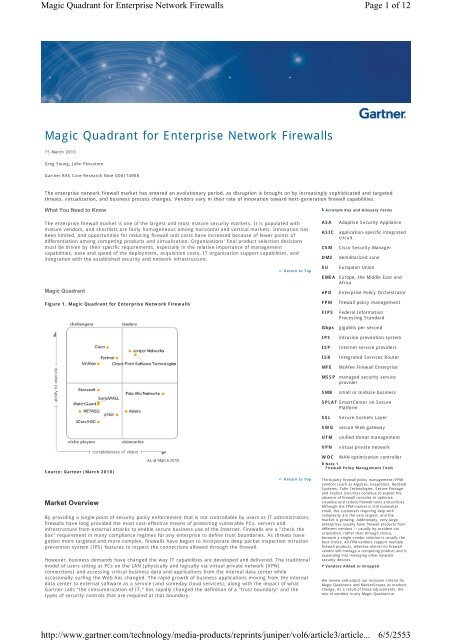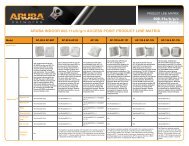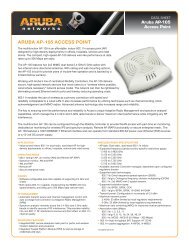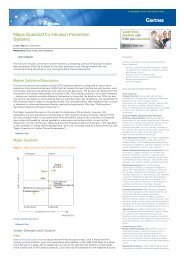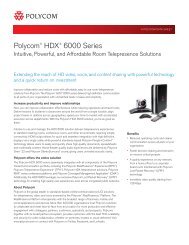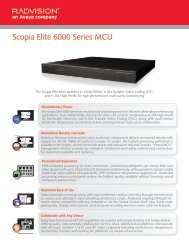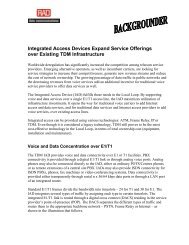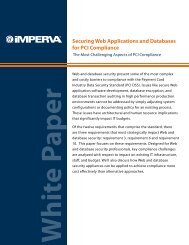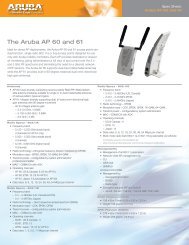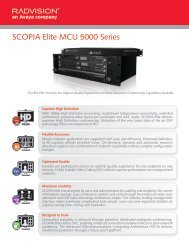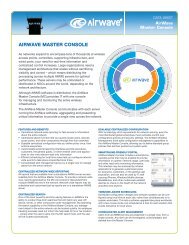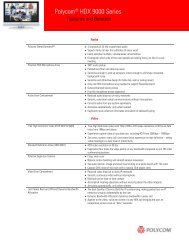Magic Quadrant for Enterprise Network Firewalls.pdf - WIT
Magic Quadrant for Enterprise Network Firewalls.pdf - WIT
Magic Quadrant for Enterprise Network Firewalls.pdf - WIT
You also want an ePaper? Increase the reach of your titles
YUMPU automatically turns print PDFs into web optimized ePapers that Google loves.
<strong>Magic</strong> <strong>Quadrant</strong> <strong>for</strong> <strong>Enterprise</strong> <strong>Network</strong> <strong>Firewalls</strong><br />
http://www.gartner.com/technology/media-products/reprints/juniper/vol6/article3/article...<br />
Page 1 of 12<br />
6/5/2553<br />
<strong>Magic</strong> <strong>Quadrant</strong> <strong>for</strong> <strong>Enterprise</strong> <strong>Network</strong> <strong>Firewalls</strong><br />
15 March 2010<br />
Greg Young, John Pescatore<br />
Gartner RAS Core Research Note G00174908<br />
The enterprise network firewall market has entered an evolutionary period, as disruption is brought on by increasingly sophisticated and targeted<br />
threats, virtualization, and business process changes. Vendors vary in their rate of innovation toward next-generation firewall capabilities.<br />
What You Need to Know<br />
The enterprise firewall market is one of the largest and most mature security markets. It is populated with<br />
mature vendors, and shortlists are fairly homogeneous among horizontal and vertical markets. Innovation has<br />
been limited, and opportunities <strong>for</strong> reducing firewall unit costs have increased because of fewer points of<br />
differentiation among competing products and virtualization. Organizations' final product selection decisions<br />
must be driven by their specific requirements, especially in the relative importance of management<br />
capabilities, ease and speed of the deployment, acquisition costs, IT organization support capabilities, and<br />
integration with the established security and network infrastructure.<br />
<strong>Magic</strong> <strong>Quadrant</strong><br />
Return to Top<br />
Acronym Key and Glossary Terms<br />
ASA<br />
ASIC<br />
CSM<br />
DMZ<br />
EU<br />
Adaptive Security Appliance<br />
application-specific integrated<br />
circuit<br />
Cisco Security Manager<br />
demilitarized zone<br />
European Union<br />
EMEA Europe, the Middle East and<br />
Africa<br />
ePO<br />
<strong>Enterprise</strong> Policy Orchestrator<br />
Figure 1. <strong>Magic</strong> <strong>Quadrant</strong> <strong>for</strong> <strong>Enterprise</strong> <strong>Network</strong> <strong>Firewalls</strong><br />
FPM<br />
FIPS<br />
firewall policy management<br />
Federal In<strong>for</strong>mation<br />
Processing Standard<br />
Gbps gigabits per second<br />
IPS<br />
ISP<br />
ISR<br />
MFE<br />
intrusion prevention system<br />
Internet service providers<br />
Integrated Services Router<br />
McAfee Firewall <strong>Enterprise</strong><br />
MSSP managed security service<br />
provider<br />
SMB<br />
small or midsize business<br />
SPLAT SmartCenter on Secure<br />
Plat<strong>for</strong>m<br />
SSL<br />
SWG<br />
UTM<br />
VPN<br />
Secure Sockets Layer<br />
secure Web gateway<br />
unified threat management<br />
virtual private network<br />
Source: Gartner (March 2010)<br />
Market Overview<br />
Return to Top<br />
By providing a single point of security policy en<strong>for</strong>cement that is not controllable by users or IT administrators,<br />
firewalls have long provided the most cost-effective means of protecting vulnerable PCs, servers and<br />
infrastructure from external attacks to enable secure business use of the Internet. <strong>Firewalls</strong> are a "check the<br />
box" requirement in many compliance regimes <strong>for</strong> any enterprise to define trust boundaries. As threats have<br />
gotten more targeted and more complex, firewalls have begun to incorporate deep packet inspection intrusion<br />
prevention system (IPS) features to inspect the connections allowed through the firewall.<br />
However, business demands have changed the way IT capabilities are developed and delivered. The traditional<br />
model of users sitting at PCs on the LAN (physically and logically via virtual private network [VPN]<br />
connections) and accessing critical business data and applications from the internal data center while<br />
occasionally surfing the Web has changed. The rapid growth of business applications moving from the internal<br />
data center to external software as a service (and someday cloud services), along with the impact of what<br />
Gartner calls "the consumerization of IT," has rapidly changed the definition of a "trust boundary" and the<br />
types of security controls that are required at that boundary.<br />
WOC<br />
WAN optimization controller<br />
Note 1<br />
Firewall Policy Management Tools<br />
Third-party firewall policy management (FPM)<br />
vendors (such as AlgoSec, Exaprotect, RedSeal<br />
Systems, Tufin Technologies, Secure Passage<br />
and Skybox Security) continue to exploit the<br />
absence of firewall consoles to optimize,<br />
visualize and reduce firewall rules and policies.<br />
Although the FPM market is still somewhat<br />
small, the customers requiring help with<br />
complexity are the very largest, and the<br />
market is growing. Additionally, very large<br />
enterprises usually have firewall products from<br />
different vendors — usually by accident via<br />
acquisition, rather than through choice,<br />
because a single vendor solution is usually the<br />
best choice. All FPM vendors support multiple<br />
firewall products, whereas almost no firewall<br />
vendor will manage a competing product and is<br />
expanding into managing other network<br />
security devices.<br />
Vendors Added or Dropped<br />
We review and adjust our inclusion criteria <strong>for</strong><br />
<strong>Magic</strong> <strong>Quadrant</strong>s and MarketScopes as markets<br />
change. As a result of these adjustments, the<br />
mix of vendors in any <strong>Magic</strong> <strong>Quadrant</strong> or
<strong>Magic</strong> <strong>Quadrant</strong> <strong>for</strong> <strong>Enterprise</strong> <strong>Network</strong> <strong>Firewalls</strong><br />
http://www.gartner.com/technology/media-products/reprints/juniper/vol6/article3/article...<br />
Page 2 of 12<br />
6/5/2553<br />
In 2009, Gartner saw market pressures accelerate the demand <strong>for</strong> next-generation firewall plat<strong>for</strong>ms that<br />
provide the capability to detect and block sophisticated attacks, as well as en<strong>for</strong>ce granular security policy at<br />
the application (versus port and protocol) level. A further disrupting factor is the rate of change within<br />
enterprise networking — inexorably increasing throughput, more Web-based applications, more complex<br />
connections within applications, more complex data centers and more data being presented to customers<br />
means that firewalls have had to keep up with features and per<strong>for</strong>mance to meet these changing needs.<br />
Branch-office firewalls and small and midsize business (SMB) firewalls continue to diverge as increasingly<br />
distinct products, with enterprises looking to their primary firewall vendors to provide the branch-office<br />
devices, along with the management tools to handle them.<br />
Although the firewall market has a relatively slow percentage of growth (appliance revenue grew 5.4% from<br />
$5.4 billion in 2007 to $5.7 billion in 2008), the market is large, and there was a lot of market activity in 2009.<br />
Firewall sales have also included a significant software, support and subscription revenue component that is<br />
not captured as part of appliance market sizing.<br />
The firewall market saw its first initial public offering (IPO) in years, as Fortinet went public in late 2009.<br />
Several high-profile acquisitions occurred as well, with McAfee buying Secure Computing, and Barracuda<br />
acquiring a controlling share of phion. Check Point Software Technologies closed on its acquisition of the Nokia<br />
network security appliance plat<strong>for</strong>m. HP's ProCurve unit announced a new firewall product; however, a few<br />
months later, HP announced that it was buying 3Com, which owns both the Tipping Point IPS appliance and<br />
the H3C firewall product. Taking a next-generation firewall approach to the market, Palo Alto <strong>Network</strong>s saw<br />
rapid growth in 2009 and meets the inclusion criteria <strong>for</strong> this edition of the Gartner <strong>Magic</strong> <strong>Quadrant</strong> <strong>for</strong><br />
<strong>Enterprise</strong> <strong>Network</strong> <strong>Firewalls</strong>.<br />
Overall, 2009 enterprise firewall revenue growth has been affected negatively due to delayed firewall refresh<br />
— driven by economic conditions rather than on any requirements changes or trends. Gartner <strong>for</strong>ecasts that<br />
the enterprise firewall appliance market will have grown less than 5% in 2009. While price pressure has<br />
continued (the average price per gigabit per second [Gbps] of firewall throughput dropped to $5,000), firewalls<br />
are still sticky and are not commoditized. However, there are many threats to the firewall industry that can<br />
further erode margins:<br />
• The cloud — Options <strong>for</strong> off-site firewall infrastructure are not <strong>for</strong> every enterprise, but along with the<br />
success of cloud-based solutions, some share of the firewall market will go into the carrier cloud. This<br />
share will be mostly new placements, rather than replacing Internet-facing enterprise firewalls. However,<br />
off-premises firewalling will see an increase.<br />
• Virtualization — <strong>Network</strong> firewalls will continue to be dominated by hardware appliances, especially at<br />
higher-throughput rates. The best-per<strong>for</strong>ming products are on highly customized hardware. The generalpurpose<br />
hardware of servers appears cost-effective but will, in practice, not deliver high network firewall<br />
throughput, and especially not when deep inspection capabilities are enabled. Nonetheless, tactical<br />
solutions <strong>for</strong> firewalls in virtualized environments will be assessed as part of selections, and appliance<br />
vendors that also have a VMware option will be scored higher. There are exceptions. For example,<br />
hosting companies or enterprise IT that operates like a hosting company will seek an all-virtualized<br />
firewalling environment.<br />
• Milking the installed base — Established vendors that are attempting to continuously increase prices<br />
without delivering proportional value in new features or just creating marketing doublespeak have been<br />
seeing displacement to more value-based vendors. In security, the new economics are that enterprises<br />
expect some increase in functionality in exchange <strong>for</strong> the vendor continuing to stay in place, often at a<br />
similar price point. Firewall policy management tools (see Note 1) make it easier to migrate between<br />
firewall vendors.<br />
• Globalization — Geography is playing an increasing role in network security selection, because local<br />
support is increasingly valued, and threat sources become regionalized. New vendors from Asia/Pacific<br />
could be a significant threat if the current vendors take their positions and market share <strong>for</strong> granted in<br />
the face of this competition.<br />
The IPsec VPNs in firewalls are somewhat commoditized and rarely play a role in shifting selections. Secure<br />
Sockets Layer (SSL) VPNs have remained primarily within stand-alone appliances, except <strong>for</strong> the SMB market.<br />
Small and lower-end midsize businesses (approximately 100 to 500 users) usually are served by the SMB<br />
multifunction firewall market. Using the same firewall vendor <strong>for</strong> main and branch offices provides a<br />
management and support advantage, rather than bringing in a second vendor focused on smaller appliances.<br />
Branch-office firewalls are distinct from SMB firewalls. The branch device is centrally managed, often has a<br />
WAN optimization controller (WOC), and does not use some safeguards that are already provided elsewhere in<br />
the enterprise (<strong>for</strong> example, anti-spam).<br />
To counteract the trends above and maintain margins, most enterprise firewall vendors will need to show how<br />
their firewall products deal with advanced threats and how they seamlessly integrate with other security<br />
products, such as secure Web gateways (SWGs), vulnerability assessments and network access control. Most<br />
of the vendors in this market sell multiple network-based security products, and have seen higher growth rates<br />
in other markets. However, the ones that manage to maintain focus on increasing the value of the network<br />
firewall will see the highest growth rates and the highest margins in 2009.<br />
Market Definition/Description<br />
Return to Top<br />
The enterprise network firewall market represented by this <strong>Magic</strong> <strong>Quadrant</strong> is composed primarily of purposebuilt<br />
appliances <strong>for</strong> securing corporate networks. Products must be able to support single enterprise firewall<br />
deployments and large deployments, including branch offices. These products are accompanied by highly<br />
scalable management and reporting consoles/products.<br />
As the firewall market continues to evolve, other security functions, such as network IPSs, will also be provided<br />
within a next-generation firewall. The next-generation firewall market will eventually subsume the stand-alone<br />
network IPS appliance market at the enterprise edge. This will not be immediate, however, because enterprise<br />
firewall vendors have IPSs within their firewall products that are competitive with stand-alone IPS appliances.<br />
Although firewall/VPN and IPS are converging (and sometimes URL filtering), other security products are not.<br />
All-in-one or unified threat management (UTM) products are suitable <strong>for</strong> SMBs but not <strong>for</strong> the enterprise.<br />
Branch-office firewalls are becoming specialized products, diverging from the SMB products.<br />
As part of increasing the effectiveness and efficiency of firewalls, firewalls will need to add more blocking<br />
capability as part of the base product, and go beyond port/protocol identification and move toward a service<br />
MarketScope may change over time. A vendor<br />
appearing in a <strong>Magic</strong> <strong>Quadrant</strong> or MarketScope<br />
one year and not the next does not necessarily<br />
indicate that we have changed our opinion of<br />
that vendor. This may be a reflection of a<br />
change in the market and, there<strong>for</strong>e, changed<br />
evaluation criteria, or a change of focus by a<br />
vendor.<br />
Evaluation Criteria Definitions<br />
Ability to Execute<br />
Product/service: Core goods and services<br />
offered by the vendor that compete in/serve<br />
the defined market. This includes current<br />
product/service capabilities, quality, feature<br />
sets and skills, whether offered natively or<br />
through OEM agreements/partnerships, as<br />
defined in the market definition and detailed in<br />
the subcriteria.<br />
Overall viability (business unit, financial,<br />
strategy, organization): Viability includes an<br />
assessment of the overall organization's<br />
financial health, the financial and practical<br />
success of the business unit, and the likelihood<br />
of the individual business unit to continue<br />
investing in the product, to continue offering<br />
the product and to advance the state of the art<br />
within the organization's portfolio of products.<br />
Sales execution/pricing: The vendor's<br />
capabilities in all presales activities and the<br />
structure that supports them. This includes<br />
deal management, pricing and negotiation,<br />
presales support and the overall effectiveness<br />
of the sales channel.<br />
Market responsiveness and track record:<br />
Ability to respond, change direction, be flexible<br />
and achieve competitive success as<br />
opportunities develop, competitors act,<br />
customer needs evolve and market dynamics<br />
change. This criterion also considers the<br />
vendor's history of responsiveness.<br />
Marketing execution: The clarity, quality,<br />
creativity and efficacy of programs designed to<br />
deliver the organization's message in order to<br />
influence the market, promote the brand and<br />
business, increase awareness of the products,<br />
and establish a positive identification with the<br />
product/brand and organization in the minds of<br />
buyers. This "mind share" can be driven by a<br />
combination of publicity, promotional, thought<br />
leadership, word-of-mouth and sales activities.<br />
Customer experience: Relationships,<br />
products and services/programs that enable<br />
clients to be successful with the products<br />
evaluated. Specifically, this includes the ways<br />
customers receive technical support or account<br />
support. This can also include ancillary tools,<br />
customer support programs (and the quality<br />
thereof), the availability of user groups and<br />
service-level agreements.<br />
Operations: The ability of the organization to<br />
meet its goals and commitments. Factors<br />
include the quality of the organizational<br />
structure, such as skills, experiences,<br />
programs, systems and other vehicles that<br />
enable the organization to operate effectively<br />
and efficiently on an ongoing basis.<br />
Completeness of Vision<br />
Market understanding: Ability of the vendor<br />
to understand buyers' wants and needs and to<br />
translate those into products and services.<br />
Vendors that show the highest degree of vision<br />
listen to and understand buyers' wants and<br />
needs, and can shape or enhance those with<br />
their added vision.<br />
Marketing strategy: A clear, differentiated<br />
set of messages consistently communicated<br />
throughout the organization and externalized<br />
through the website, advertising, customer<br />
programs and positioning statements.<br />
Sales strategy: The strategy <strong>for</strong> selling<br />
product that uses the appropriate network of<br />
direct and indirect sales, marketing, service<br />
and communication affiliates that extend the<br />
scope and depth of market reach, skills,<br />
expertise, technologies, services and the<br />
customer base.<br />
Offering (product) strategy: The vendor's<br />
approach to product development and delivery<br />
that emphasizes differentiation, functionality,<br />
methodology and feature set as they map to<br />
current and future requirements.<br />
Business model: The soundness and logic of<br />
the vendor's underlying business proposition.<br />
Vertical/industry strategy: The vendor's<br />
strategy to direct resources, skills and<br />
offerings to meet the specific needs of<br />
individual market segments, including vertical<br />
industries.
<strong>Magic</strong> <strong>Quadrant</strong> <strong>for</strong> <strong>Enterprise</strong> <strong>Network</strong> <strong>Firewalls</strong><br />
http://www.gartner.com/technology/media-products/reprints/juniper/vol6/article3/article...<br />
Page 3 of 12<br />
6/5/2553<br />
view of traffic.<br />
Return to Top<br />
Innovation: Direct, related, complementary<br />
and synergistic layouts of resources, expertise<br />
or capital <strong>for</strong> investment, consolidation,<br />
defensive or pre-emptive purposes.<br />
Inclusion and Exclusion Criteria<br />
Inclusion Criteria<br />
Geographic strategy: The vendor's strategy<br />
to direct resources, skills and offerings to meet<br />
the specific needs of geographies outside the<br />
"home" or native geography, either directly or<br />
through partners, channels and subsidiaries, as<br />
appropriate <strong>for</strong> that geography and market.<br />
<strong>Network</strong> firewall companies that meet the market definition and description were considered <strong>for</strong> this report<br />
under the following conditions:<br />
• Gartner analysts assess that the company has an ability to effectively compete in the enterprise market.<br />
• Gartner clients generate inquiries about the company.<br />
• The company regularly appears on shortlists <strong>for</strong> selection and purchases.<br />
• The company demonstrates a competitive presence in enterprises and sales.<br />
• Gartner analysts consider that aspects of the company's product execution and vision are important<br />
enough to merit inclusion.<br />
• The vendor has achieved enterprise firewall product sales (not including maintenance) in the past year of<br />
more than $10 million and within a customer segment that is visible to Gartner.<br />
Exclusion Criteria<br />
<strong>Network</strong> firewall companies that were not included in this report may have been excluded <strong>for</strong> one or more of<br />
the following conditions:<br />
• The company didn't supply sufficient in<strong>for</strong>mation <strong>for</strong> assessment or did not meet the inclusion criteria.<br />
• The company has minimal or negligible apparent market share among Gartner clients, or is not actively<br />
shipping products.<br />
• The company is not the original manufacturer of the firewall product. That includes hardware OEMs,<br />
resellers that repackage products that would qualify from their original manufacturers, as well as carriers<br />
and Internet service providers (ISPs) that provide managed services. We assess the breadth of OEM<br />
partners as part of the evaluation of the firewall, and do not rate plat<strong>for</strong>m providers separately.<br />
• The company's products sell as network firewalls, but do not have the capabilities, scalability and ability<br />
to directly compete with the larger firewall product/function view. Products that are suited <strong>for</strong> SMBs,<br />
such as multifunction firewalls or those <strong>for</strong> small office/home office placements, are not targeted at the<br />
market this <strong>Magic</strong> <strong>Quadrant</strong> covers (enterprise) and are excluded.<br />
• The company has primarily a network IPS with a nonenterprise-class firewall.<br />
• The company has personal firewalls, host-based firewalls, host-based IPSs and Web application firewalls<br />
— all of which are distinctly separate markets.<br />
Stand-alone network IPS appliances are a distinct market and are covered in Gartner's <strong>Magic</strong> <strong>Quadrant</strong> <strong>for</strong><br />
Intrusion Prevention Systems.<br />
Return to Top<br />
Vendors Added<br />
• Palo Alto <strong>Network</strong>s<br />
• 3Com/H3C<br />
Return to Top<br />
Vendors Dropped<br />
No vendors were dropped. Name changes did occur as a result of acquisitions, with Secure Computing changed<br />
to McAfee. Although phion was acquired by Barracuda, the phion brand is still being maintained as distinct in<br />
the primary sales base. Gartner examined several vendors that did not meet the inclusion criteria, or were<br />
nonresponsive and did not have any significant visibility within the market.<br />
Return to Top<br />
Evaluation Criteria<br />
Ability to Execute<br />
• Product or service: This includes service and customer satisfaction in deployments. Execution considers<br />
factors related to getting products sold, installed, supported and in users' hands. Strong execution<br />
means that a company has demonstrated to Gartner analysts that products are successfully and<br />
continuously deployed in enterprises, and the company wins a large percentage in competition with<br />
other vendors. Companies that execute strongly generate pervasive awareness and loyalty among<br />
Gartner clients, and generate a steady stream of inquiries to Gartner analysts. Execution is not primarily<br />
about company size or market share, although those factors can affect a company's ability to execute.<br />
Sales are a factor; however, winning in competitive environments through innovation and quality of<br />
product is <strong>for</strong>emost over revenue. Key features are weighted heavily, such as virtualization, console<br />
quality, low latency, range of models, secondary product capabilities (logging, event management,<br />
compliance, rule optimization and workflow), and being able to support complex deployments and<br />
modern demilitarized zones (DMZs). Having a low rate of vulnerabilities in the firewall is important.<br />
• Overall viability: Overall business viability includes overall financial health, prospects <strong>for</strong> continuing<br />
operations, company history, and demonstrated commitment in the firewall and security market. Growth<br />
of the customer base and revenue derived from sales are also considered. All vendors were required to<br />
disclose comparable market data, such as firewall revenue, competitive wins versus key competitors<br />
(which is compared to Gartner data on such competitions held by our customers), and devices in<br />
deployment. The number of firewalls shipped or the market share is not the key measure of execution.<br />
Instead, we consider use of these firewalls to protect the key business systems of enterprise clients and
<strong>Magic</strong> <strong>Quadrant</strong> <strong>for</strong> <strong>Enterprise</strong> <strong>Network</strong> <strong>Firewalls</strong><br />
http://www.gartner.com/technology/media-products/reprints/juniper/vol6/article3/article...<br />
Page 4 of 12<br />
6/5/2553<br />
presence on competitive shortlists.<br />
• Sales execution/pricing: We evaluate the company's pricing, deal size, installed base and use by<br />
enterprises, carriers and managed security service providers (MSSPs). This includes the strength of the<br />
vendor's sales and distribution operations. Pre- and post-sales support are evaluated. Pricing is<br />
compared in terms of a typical enterprise-class deployment, including the cost of all hardware, support,<br />
maintenance and installation. Low pricing will not guarantee high execution or client interest. Buyers<br />
want good results more than they want bargains. Cost of ownership over a typical firewall life cycle<br />
(three to five years) was assessed, as was the pricing model <strong>for</strong> (1) conducting a refresh while staying<br />
with the same product and (2) replacing a competing product without intolerable costs or interruptions.<br />
• Market responsiveness and track record: This evaluates the vendor's ability to respond to changes in the<br />
threat environment, and to present solutions that meet customer protection needs rather than packaging<br />
up fear, uncertainty and doubt. This criterion also considers the provider's history of responsiveness to<br />
changes in the firewall market.<br />
• Market execution: Competitive visibility is a key factor, including which vendors are most commonly<br />
considered top competitive solutions, during the RFP and selection process, and which are considered<br />
top threats by each other. In addition to buyer and analyst feedback, this ranking looks at which vendors<br />
consider each other to be direct competitive threats, such as driving the market on innovative features<br />
copackaged within the firewall, or offering innovative pricing or support offerings. A next-generation<br />
firewall capability is heavily weighted, as are enterprise-class capabilities, such as multidevice<br />
management, virtualization, adaptability of configuration and support <strong>for</strong> enterprise environments.<br />
Unacceptable device failure rates, vulnerabilities, poor per<strong>for</strong>mance and the inability of a product to<br />
survive to the end of a typical firewall life span are assessed accordingly. Significant weighting is given<br />
to delivering new plat<strong>for</strong>ms <strong>for</strong> scalable per<strong>for</strong>mance in order to maintain investment, and to the range<br />
of models to support various deployment architectures.<br />
• Customer experience and operations: This includes management experience and track record, as well as<br />
the depth of staff experience specifically in the security marketplace. The greatest factor in this category<br />
is customer satisfaction throughout the sales and product life cycle. Also important is low latency,<br />
throughput of the IPS capability, and how the firewall fared under attack conditions. Succeeding in<br />
complex networks with little intervention (<strong>for</strong> example, one-off patches) is highly considered.<br />
Table 1. Ability to Execute Evaluation Criteria<br />
Evaluation Criteria<br />
Weighting<br />
Product/Service<br />
High<br />
Overall Viability (Business Unit, Financial, Strategy, Organization) Standard<br />
Sales Execution/Pricing<br />
Standard<br />
Market Responsiveness and Track Record<br />
Standard<br />
Marketing Execution<br />
Standard<br />
Customer Experience<br />
High<br />
Operations<br />
Standard<br />
Source: Gartner (March 2010)<br />
Return to Top<br />
Completeness of Vision<br />
• Market understanding and strategy: This includes providing a track record of delivering on innovation<br />
that precedes customer demand rather than an "us too" road map. We also evaluate the vendor's overall<br />
understanding and commitment to the security and network security markets. Gartner makes this<br />
assessment subjectively by several means, including interaction with vendors in briefings and feedback<br />
from Gartner customers on in<strong>for</strong>mation they receive concerning road maps. Incumbent vendor market<br />
per<strong>for</strong>mance is reviewed year by year against specific recommendations that have been made to each<br />
vendor and against future trends identified in Gartner research. Vendors cannot merely state an<br />
aggressive future goal; they must put a plan in place, show that they are following their plan and modify<br />
their plan as they <strong>for</strong>ecast the market directions will change.<br />
• Sales strategy: Sales strategy includes pre- and post-product support, value <strong>for</strong> pricing, and providing<br />
clear explanations and recommendations <strong>for</strong> detection events. Building loyalty through credibility with<br />
full-time enterprise firewall staff demonstrates the ability to assess the next generation of requirements.<br />
Vendors need to address the network security buying center correctly, and to do so in a technically<br />
direct manner, rather than selling just fear.<br />
• Offering strategy: This criterion focuses on a vendor's product road map, current features, nextgeneration<br />
firewall integration, virtualization and per<strong>for</strong>mance. Credible independent third-party<br />
certifications include the Common Criteria <strong>for</strong> In<strong>for</strong>mation Technology Security Evaluation. Integrating<br />
with other security components is also weighted, as well as product integration into other IT systems.<br />
We also evaluate how the vendor understands and serves the enterprise branch office.<br />
• Business model: This includes the process and success rate <strong>for</strong> developing new features and innovation,<br />
and R&D spending.<br />
• Vertical, industry and geographic strategy: This includes the ability and commitment to service<br />
geographies and vertical markets, such as international deployments, MSSPs, carriers or governments.<br />
• Innovation: This includes R&D and quality differentiators, such as:<br />
• Per<strong>for</strong>mance, which includes low latency, new firewall mechanisms and achieving high IPS<br />
throughput<br />
• Firewall virtualization and securing virtualized environments<br />
• Integration with other security products<br />
• Management interface and clarity of reporting — the more a product mirrors the workflow of the<br />
enterprise operation scenario, the better the vision<br />
Products that are not intuitive in deployments or operations are difficult to configure or have limited reporting,<br />
and they are scored accordingly.<br />
The more a product mirrors the workflow of the enterprise operation scenario, the better the vision. Products<br />
that are not intuitive in deployment, or operations that are difficult to configure or have limited reporting, are<br />
scored accordingly. Solving customer problems is a key element of this category. Reducing the rule base,<br />
offering interproduct support and leading competitors on features are <strong>for</strong>emost.
<strong>Magic</strong> <strong>Quadrant</strong> <strong>for</strong> <strong>Enterprise</strong> <strong>Network</strong> <strong>Firewalls</strong><br />
http://www.gartner.com/technology/media-products/reprints/juniper/vol6/article3/article...<br />
Page 5 of 12<br />
6/5/2553<br />
Table 2. Completeness of Vision<br />
Evaluation Criteria<br />
Evaluation Criteria Weighting<br />
Market Understanding Standard<br />
Marketing Strategy Standard<br />
Sales Strategy<br />
Low<br />
Offering (Product) Strategy High<br />
Business Model<br />
Standard<br />
Vertical/Industry Strategy Standard<br />
Innovation<br />
High<br />
Geographic Strategy Standard<br />
Source: Gartner (March 2010)<br />
Return to Top<br />
Leaders<br />
The Leaders quadrant contains a mix of large and midsize vendors, with the common element of making<br />
products that are built <strong>for</strong> enterprise requirements. These requirements include a wide range of models,<br />
support <strong>for</strong> virtualization and virtual LANs, and a management and reporting capability that is designed <strong>for</strong><br />
complex and high-volume environments, such as multitier administration and rules/policy minimization. A<br />
next-generation firewall capability is an important element as enterprises move away from having dedicated<br />
IPS appliances at their perimeter and remote locations. Vendors in this quadrant lead the market in offering<br />
new safeguarding features, providing expert capability, rather than treating the firewall as a commodity, and<br />
having a good track record of avoiding vulnerabilities in their security products. Common characteristics<br />
include handling the highest throughput with minimal per<strong>for</strong>mance loss and options <strong>for</strong> hardware acceleration.<br />
Return to Top<br />
Challengers<br />
The Challengers quadrant contains vendors that have achieved a sound customer base, but they are not<br />
leading with features. Many challengers are slow to work toward or do not plan <strong>for</strong> a next-generation firewall<br />
capability, or they have other security products that are successful in the enterprise and are counting on the<br />
relationship, rather than the product, to win deals. Challenger products are often well-priced and, because of<br />
their strength in execution, vendors can offer economic security product bundles that others cannot. Many<br />
challengers hold themselves back from becoming leaders because they are obligated to place security or<br />
firewall products as a lower priority in their overall product sets. Firewall market challengers will often have<br />
significant market share but trail smaller market share leaders in the release of features.<br />
Return to Top<br />
Visionaries<br />
Visionaries have the right designs and features <strong>for</strong> the enterprise, but they lack the sales base, strategy or<br />
financial means to compete with leaders and challengers. Most visionary products have a good next-generation<br />
firewall capability but lack the per<strong>for</strong>mance capability and support network. Savings and high-touch support<br />
can be achieved <strong>for</strong> organizations willing to update products more frequently and switch vendors if required.<br />
Where firewalling is a competitive element <strong>for</strong> an enterprise, visionary vendors are good shortlist candidates.<br />
Return to Top<br />
Niche Players<br />
Most vendors in the Niche Players quadrant are smaller vendors of enterprise firewalls, makers of multifunction<br />
firewalls <strong>for</strong> SMBs, or branch-office-only product makers attempting to break into the enterprise market. Many<br />
niche companies are making larger SMB products, with the mistaken hope that this will satisfy enterprises.<br />
Some enterprises that have the firewall needs of an SMB (<strong>for</strong> example, some Type C "risk-averse" enterprises)<br />
may consider niche products, although other models from leaders and challengers may be more suited. If local<br />
geographic support is a critical factor, then niche products can be shortlisted.<br />
Return to Top<br />
Vendor Strengths and Cautions<br />
3Com/H3C<br />
China-based H3C (see www.h3c.com) was <strong>for</strong>med as a joint partnership between Huawei and 3Com, and<br />
became wholly owned by 3Com in 2007. Recently, HP announced the acquisition of 3Com. Shipping firewalls<br />
since 2003, H3C firewalls have been seeing increased placement, usually as part of H3C's network<br />
infrastructure projects. H3C SecPath firewalls will be of interest to China-based enterprises, especially where<br />
other H3C, 3Com or Huawei networking equipment is used. H3C is assessed as a niche vendor primarily due to<br />
its geographic sales and presence.<br />
Return to Top
<strong>Magic</strong> <strong>Quadrant</strong> <strong>for</strong> <strong>Enterprise</strong> <strong>Network</strong> <strong>Firewalls</strong><br />
http://www.gartner.com/technology/media-products/reprints/juniper/vol6/article3/article...<br />
Page 6 of 12<br />
6/5/2553<br />
Strengths<br />
• H3C has a strong regional presence in China and the Asia/Pacific region.<br />
• It has a wide model range, including branch-office and blade-based firewalls, as well as a flat-fee URL<br />
model.<br />
• It has broad IPv6 support.<br />
Return to Top<br />
Cautions<br />
• All of H3C's placements are in the Asia/Pacific region.<br />
• Its firewall lacks certifications and third-party testing, such as Common Criteria <strong>for</strong> In<strong>for</strong>mation<br />
Technology Security Evaluation, which is usually seen in enterprise contenders.<br />
• H3C's high patch rate is a concern <strong>for</strong> high-assurance placements.<br />
• HP has not clearly delineated a long-term strategy in the network security market.<br />
Return to Top<br />
Astaro<br />
Headquartered in Germany, Astaro (see www.astaro.com) has been shipping firewall products since 2001. The<br />
majority of its customers are in Europe, the Middle East and Africa (EMEA); however, the greatest growth is in<br />
the U.S., as a result of expanded operations out of the Boston, Massachusetts, area. Astaro leverages opensource<br />
components and focuses on software. Astaro represents a long-term competitive threat, because it<br />
targets midsize requirements and growth with those customers. Its competitiveness on price will be of interest<br />
where budgets are tight and the security requirements are not exceptional. Astaro is assessed as a visionary<br />
vendor <strong>for</strong> enterprises mostly because it wins over leaders in some selections based on features but does not<br />
have broad market reach or channel strength.<br />
Return to Top<br />
Strengths<br />
• Users like Astaro's clustering features and price, and ease of installation is reported as a strong point.<br />
The Astaro Security Gateway supports a high number of concurrent connections.<br />
• Astaro's leverage and integration of a wide range of open-source components provide an attractive price<br />
point. There is no extra charge <strong>for</strong> the management product and, of great interest, it offers a free basic<br />
firewall version <strong>for</strong> use in VMware.<br />
• Astaro was early in having a VMware-certified version of its firewall. Additionally, the Astaro Security<br />
Gateway is available as an appliance or software load.<br />
• It has exhibited strong growth in its firewall business, and Astaro has SWG and mail security gateway<br />
offerings. Customer satisfaction is generally high, especially with post-sales technical support.<br />
Return to Top<br />
Cautions<br />
• Astaro has limited visibility outside of EMEA and limited channel strength.<br />
• Users would like improved reporting, and Astaro's VPN does not have Federal In<strong>for</strong>mation Processing<br />
Standard (FIPS) 140-2 certification.<br />
• Its UTM focus is less a match <strong>for</strong> enterprises and better <strong>for</strong> SMBs. Astaro is short on enterprise features<br />
(such as supporting multiple firewall instances in the same appliance) and usually competes with other<br />
SMB firewall vendors.<br />
• Astaro was not listed by any vendor we surveyed as a significant enterprise competitive threat.<br />
Return to Top<br />
Check Point Software Technologies<br />
Check Point Software Technologies (see www.checkpoint.com) is a well-known, pure-play security company<br />
with a well-entrenched installed base and a strong, established channel. Check Point has had two critical<br />
events occur since the last issue of this <strong>Magic</strong> <strong>Quadrant</strong>: completing the acquisition of the Nokia security<br />
products unit, and the R70 release. The Nokia unit acquisition and hardware line expansions <strong>for</strong> UTM-1 and<br />
Power-1 lines put pressure on owners of plat<strong>for</strong>ms provided by the remaining Check Point plat<strong>for</strong>m partners to<br />
migrate to Check Point-branded appliances. Gartner believes that Check Point will, over time, blend the IPSO<br />
and SmartCenter on Secure Plat<strong>for</strong>m (SPLAT) operating systems into a new SPLAT version. Check Point is<br />
assessed as a leader <strong>for</strong> enterprises because we continuously see the vendor competing and winning in<br />
demanding selections, and displacing competitors based on its features and channel strength.<br />
Return to Top<br />
Strengths<br />
• Check Point scored high as a significant enterprise competitive threat by the vendors Gartner surveyed.<br />
• Provider-1 is valued highly by customers with a large number of firewalls, and overall, Check Point<br />
firewalls are most often seen in large and complex networks.<br />
• The R70 release had a significant number of features and improvements, which increased competitive<br />
pressure significantly across the firewall market.<br />
• Check Point has a strong field of product options, such as VSX <strong>for</strong> virtualized firewalling and its Eventia<br />
correlation product. SecurePlat<strong>for</strong>m allows <strong>for</strong> a loading of the firewall, along with a hardened operating<br />
system onto off-the-shelf server hardware. The wide availability of appliance and software options<br />
enables Check Point to meet the requirements <strong>for</strong> complex enterprise networks.<br />
• Its SmartCenter management console is a strong and mature interface with the ability to handle
<strong>Magic</strong> <strong>Quadrant</strong> <strong>for</strong> <strong>Enterprise</strong> <strong>Network</strong> <strong>Firewalls</strong><br />
http://www.gartner.com/technology/media-products/reprints/juniper/vol6/article3/article...<br />
Page 7 of 12<br />
6/5/2553<br />
complex DMZ deployments and large numbers of devices. Check Point always scores very high in<br />
console quality in selections. Provider-1 users we surveyed generally report a high level of satisfaction.<br />
• Check Point has good capability <strong>for</strong> servicing large enterprises with the combination of its Power-1<br />
appliance line, having a VMware-certified version (VPN-1 VE) and VPN-1 UTM running in a container on<br />
ESX and Provider-1.<br />
Return to Top<br />
Cautions<br />
• Price is the primary reason that Gartner customers provide <strong>for</strong> replacing or considering replacing Check<br />
Point firewalls. This is not an issue where a premium firewall function is required.<br />
• The Check Point Software Blade architecture will not be viewed as different from a software key or<br />
existing competitive offerings until Check Point takes steps to further link hardware and the Software<br />
Blade function.<br />
• Check Point remains secretive about its road map and longer-term strategies, sometimes leaving its<br />
customers guessing and vulnerable to replacement by competitors.<br />
• The vendor remains challenged in succeeding with network security products outside the firewall market,<br />
limiting the opportunities to bring firewall to customers as an expansion of existing spending. Check<br />
Point has diluted the possibility of a broader network security focus as it tries to attack desktop security.<br />
Check Point is missing significant growth opportunities in e-mail, stand-alone IPS and Web security, and<br />
will continue to be challenged by replacement by competing vendors.<br />
• Gartner believes that Check Point has invested significantly in its IPS; however, we still have not seen<br />
significant Gartner customer deployments of the IPS software blade. Check Point needs to demonstrate<br />
to the market that the IPS software blade is an improvement from SmartDefense and demonstrate a<br />
broader next-generation firewall capability.<br />
Return to Top<br />
Cisco<br />
Although marketed otherwise, Cisco (see www.cisco.com) security products do not require Cisco networking<br />
equipment to be present, nor does having Cisco networking equipment mandate Cisco security products.<br />
Through its acquisition of IronPort, Cisco has strong product offerings across the network security, Web<br />
security and e-mail security tiers. Cisco has continued to consolidate its security products into a single<br />
business unit. Gartner believes that Cisco is in a strong position to launch "security as a service" and datacenter-specific<br />
security offerings. Cisco firewalls have not seen any noteworthy changes in 2009; however,<br />
Gartner <strong>for</strong>ecasts that changes within the Cisco security unit will be realized with increased competitiveness<br />
from 2H10 through 2011. Cisco is assessed as a challenger <strong>for</strong> enterprises because we do not see it<br />
continuously displacing leaders based on vision or feature, but instead through sales/channel execution or<br />
aggressive discounting <strong>for</strong> large Cisco networks when firewall features are not in high demand.<br />
Return to Top<br />
Strengths<br />
• Cisco has significant market share in security (including having the largest market share <strong>for</strong> firewall<br />
appliances), has wide geographic support and is viewed as a significant (second-highest) enterprise<br />
competitive threat by the vendors we surveyed.<br />
• The Cisco support network is a strong positive <strong>for</strong> larger customers.<br />
• Its Adaptive Security Appliance (ASA) has the option to add an IPS module (AIP-SSM) to replace a<br />
stand-alone IPS. The ASA is available in four editions, which clearly define what safeguards are being<br />
purchased.<br />
• Cisco offers a wide choice in firewall plat<strong>for</strong>ms. The primary offering is the stand-alone firewall/VPN ASA,<br />
with firewalls also available via the Firewall Services Module blade <strong>for</strong> Catalyst switches, and on Cisco's<br />
IOS-based Integrated Services Router (ISR).<br />
• The vendor has strong channels, broad geographic support and the availability of other security<br />
products.<br />
• The integration of reputation features across Cisco security products is a highly significant feature<br />
differentiator that is often missed in enterprise selections.<br />
Return to Top<br />
Cautions<br />
• Cisco remains elusive on competitive firewall shortlists by Gartner customers. Cisco firewall products are<br />
selected more often when security offerings are added to Cisco's infrastructure, rather than when there<br />
is a shortlist with competing firewall appliances. Cisco was listed by competitors as the product they<br />
most replace. This is likely to change as the PIX replacement cycle ebbs. This is not a strong caution,<br />
given Cisco's market share.<br />
• Where Cisco firewalls were shortlisted, but not selected, quality and usability of the management<br />
console, Cisco Security Manager (CSM), were consistently the factors most often cited.<br />
• Cisco firewall and security products continue to have one of the highest rates of published product<br />
vulnerabilities. Although Cisco is a high-profile target, security products must have a higher level of<br />
assurance than general-purpose products.<br />
• The requirement to add a hardware module (the AIP-SSM) to add IPS capability to the ASA firewall<br />
appliance remains a barrier to deployment and a competitive disadvantage <strong>for</strong> branch-office<br />
deployments. The add-in module does, however, provide processing help with the deep inspection load.<br />
If the SSM module is used <strong>for</strong> IPS, then it cannot be used <strong>for</strong> other content inspection.<br />
• Two products (usually CSM and CS-MARS) are required <strong>for</strong> most management functions, whereas<br />
competitors have a single product.<br />
• The ASA line is becoming somewhat dated and, although Gartner expects Cisco to introduce new<br />
models, Cisco often is excluded from placements with high throughput. Cisco's Firewall Services Module<br />
(FWSM) and ISR have been on a separate firewall development stream (closer to the PIX code base) and<br />
haven't benefited from ASA advances.<br />
Return to Top
<strong>Magic</strong> <strong>Quadrant</strong> <strong>for</strong> <strong>Enterprise</strong> <strong>Network</strong> <strong>Firewalls</strong><br />
http://www.gartner.com/technology/media-products/reprints/juniper/vol6/article3/article...<br />
Page 8 of 12<br />
6/5/2553<br />
Fortinet<br />
Although SMBs have been the primary market <strong>for</strong> Fortinet firewalls from this Cali<strong>for</strong>nia-based company (see<br />
www.<strong>for</strong>tinet.com), unlike most SMB competitors, Fortinet has high-end appliances and a hardware<br />
engineering capability. Fortinet had its IPO in late 2009, which provides increased visibility into the company<br />
and greater financial resources. Although the move into the enterprise is slow within the Gartner customer<br />
base, Fortinet remains a significant threat to competitors in this market because of its high-end hardware and<br />
steady revenue growth. Unlike other SMB-focused firewall vendors, Fortinet is a viable shortlist contender <strong>for</strong> a<br />
good segment of the enterprise firewall market. Fortinet is assessed as a challenger mostly because we see it<br />
displacing competitors, although on value and per<strong>for</strong>mance and not in classic enterprise selections.<br />
Return to Top<br />
Strengths<br />
• Users consistently like the continued pace of development and delivery of Fortinet's new features and<br />
products, and report easy deployment. By developing rather than using OEMs <strong>for</strong> most safeguards,<br />
Fortinet has been able to maintain road map agility. This also has allowed Fortinet to expand its portfolio<br />
of nonfirewall network security offerings, which provides increasing cross-selling opportunities.<br />
• Fortinet is increasing its wins against market leaders, and it gained additional footholds in emerging<br />
areas, such as in-the-cloud firewalls and with carriers/ISPs.<br />
• Its firewalls have good per<strong>for</strong>mance from purpose-built hardware and a wide model range, including<br />
bladed appliances <strong>for</strong> large enterprises and carriers, as well as SMB and branch-office solutions.<br />
• The new dual application-specific integrated circuit (ASIC) strategy used in newer models is a significant<br />
per<strong>for</strong>mance enabler. The AMC expansion slot options <strong>for</strong> the enterprise-class models include an onboard<br />
security ASIC with additional ports, or a hard drive providing investment preservation without having to<br />
resort to only appliance replacement, like many competitors.<br />
• Fortinet is price-competitive, especially when using multiple virtual domains, and appliance reliability is<br />
reported as very high.<br />
Return to Top<br />
Cautions<br />
• Where Fortinet was shortlisted but not selected in enterprises, the IPS was most often listed as the<br />
reason. Post-sales service and support did not get high ratings from users. Gartner believes this is<br />
because of the high growth rate of Fortinet and the challenge in growing the support network at the<br />
same pace.<br />
• Marketing focused on using UTM <strong>for</strong> enterprises undervalues Fortinet's enterprise offerings and steers<br />
away larger customers.<br />
• Gartner rarely sees Fortinet in most traditional enterprise firewall selections.<br />
• Its IPO will be a distraction <strong>for</strong> the management team.<br />
Return to Top<br />
Juniper <strong>Network</strong>s<br />
Juniper <strong>Network</strong>s' (see www.juniper.net/us/en) firewalls have continued to progress since the acquisition of<br />
NetScreen Technologies in 2004. Unlike Cisco, Gartner sees Juniper firewalls being selected independently<br />
from the network infrastructure business by enterprises that are not otherwise Juniper customers. The move to<br />
Junos from ScreenOS, along with the SRX model line, are the most significant changes in the Juniper firewalls.<br />
Juniper is assessed as a leader <strong>for</strong> enterprises, because we continuously see it competing and winning in<br />
demanding selections, and displacing competitors based on its vision or features.<br />
Return to Top<br />
Strengths<br />
• Per<strong>for</strong>mance, range of models and technical support were most often listed by users as what they like<br />
about Juniper firewalls. Post-sales support was rated highly by users, although first-line support<br />
satisfaction is more mixed. Firewall deep inspection is rated as satisfactory by users but is not<br />
competitive with most stand-alone IPSs. Juniper was listed by the majority of vendors as the greatest<br />
competitor.<br />
• Good options exist <strong>for</strong> high-end, purpose-built appliances, especially in the higher-end SRX models, and<br />
Juniper expresses a clear road map <strong>for</strong> firewall and security customers. Juniper has shown development<br />
and security discipline in keeping the rate of vulnerabilities in the product low.<br />
• Juniper has strong branch-office firewalls, complementing the enterprise products. Its branch-office<br />
firewalls include WOC and an Avaya voice gateway.<br />
• Having routing in the firewall is of interest to a narrow segment of customers.<br />
Return to Top<br />
Cautions<br />
• The Adaptive Threat Management messaging doesn't resonate in the market, and Juniper needs to get<br />
back to competing on price, per<strong>for</strong>mance and features. Juniper remains competitive but generally did not<br />
drive the market from a vision perspective in 2009 relative to competitors.<br />
• As a network infrastructure vendor, rather than a pure-play security vendor, Juniper is at a disadvantage<br />
selling into Cisco networks, where buying any Juniper equipment can be resisted as a Cisco network<br />
equipment replacement.<br />
• Like most competitors, integration between IPS and the firewall is limited, although Juniper has one of<br />
the better in-the-firewall IPSs on the market.<br />
• Juniper is generally high-priced and often allows competitors an opening on price alone; however,<br />
customers report that they recognize the value/price proposition.
<strong>Magic</strong> <strong>Quadrant</strong> <strong>for</strong> <strong>Enterprise</strong> <strong>Network</strong> <strong>Firewalls</strong><br />
http://www.gartner.com/technology/media-products/reprints/juniper/vol6/article3/article...<br />
Page 9 of 12<br />
6/5/2553<br />
Return to Top<br />
McAfee<br />
Although primarily a host-based security company, McAfee (see www.mcafee.com/us) has had success in the<br />
network security market, notably with its network IPS. McAfee obtained its firewall products through the<br />
acquisition of Secure Computing in late 2008. The Sidewinder product has been renamed to the McAfee<br />
Firewall <strong>Enterprise</strong> (MFE). Today, the road map <strong>for</strong> MFE is more important <strong>for</strong> consideration than the current<br />
features in the product. Re-engineering the MFE to gain feature and hardware parity is not a trivial task.<br />
However, Gartner believes that, if McAfee maintains the road map and focus on network security, then it could,<br />
in the midterm, become the next significant firewall market disrupter and a potential market leader. A reengineered<br />
MFE integrated with the McAfee IPS on a purpose-built hardware plat<strong>for</strong>m will be the milestone <strong>for</strong><br />
which to watch. McAfee is assessed as a challenger <strong>for</strong> enterprises, because we do not see it continuously<br />
displacing leaders based on vision or feature, but instead through sales execution or value when features are<br />
not in high demand.<br />
Return to Top<br />
Strengths<br />
• McAfee could have a road map toward a next-generation firewall by embedding the Sidewinder firewall<br />
with the McAfee IPS, and onto a more purpose-built hardware, although this will not occur in the short<br />
term.<br />
• The TrustedSource feature blocks known bad IP addresses (from a dynamically updated list source) from<br />
connecting to the firewall, and is a significant differentiating feature.<br />
• Having a good record as being free from vulnerabilities, the MFE offers strong features <strong>for</strong> government,<br />
military and other "security first" requirements.<br />
• The vendor's integration of reputation services across network, Web and e-mail security product lines<br />
provides a strong cross-selling opportunity. The larger McAfee sales and channels have already increased<br />
MFE presence in the market, while changes to the product are under way.<br />
• McAfee has more network security products across multiple markets than almost any competitor. The<br />
prospect of integrating these products represents potential "glue" between silo products, which few<br />
competitors can yet promise.<br />
Return to Top<br />
Cautions<br />
• Gartner believes that firewall manageability will be decreased if McAfee tries to focus on migrating<br />
firewall and IPS management under its desktop-oriented <strong>Enterprise</strong> Policy Orchestrator (ePO) console;<br />
however, McAfee has not done this with its other network security products and is disciplined in<br />
maintaining the current road map.<br />
• MFE has low firewall market visibility against market leaders. Gartner rarely sees McAfee firewalls<br />
competing in enterprise customer shortlists.<br />
• McAfee has a small range of models. The <strong>for</strong>mer SnapGear firewall renamed to McAfee UTM is designed<br />
more <strong>for</strong> SMBs than enterprise branch offices.<br />
Return to Top<br />
NETASQ<br />
Headquartered in France, NETASQ (see www.netasq.com) has been a pure-play network security vendor <strong>for</strong><br />
more than 10 years. With an all-in-one or UTM approach, NETASQ appeals to midsize companies and EU-based<br />
enterprises. NETASQ is assessed as a niche vendor <strong>for</strong> enterprises, mostly because it best serves midsize<br />
businesses and agencies in portions of EMEA or when the leaders are otherwise not welcome. We do not see<br />
NETASQ frequently displacing leaders otherwise.<br />
Return to Top<br />
Strengths<br />
• NETASQ has a good mix of features in comparison to competitors in its class. Users report that they like<br />
its policy-based management and real-time policy warning.<br />
• It is VPN-certified under <strong>for</strong> use <strong>for</strong> "EU restraint" <strong>for</strong> the European Union (EU), which is of interest to<br />
governments and agencies looking <strong>for</strong> simpler procurement.<br />
• NETASQ is focused on the requirements of midsize customers and provides good channel support.<br />
• Users report that NETASQ's appliance throughput lives up to its per<strong>for</strong>mance claims, likely due to the<br />
ASQ inspection handling engine.<br />
• An EU-based vendor will be attractive to EU users, especially in France, and support is viewed very<br />
positively by Gartner clients.<br />
Return to Top<br />
Cautions<br />
• NETASQ has a narrow international base, with almost all its deployments in EMEA, especially France.<br />
• The product focus is less a match <strong>for</strong> large enterprises and better <strong>for</strong> SMBs. Like most SMB-focused<br />
firewall companies, NETASQ does not offer a high end of appliances <strong>for</strong> larger enterprises; however, its<br />
sales success has been on serving organizations of less than 1,000 employees.<br />
• NETASQ was not listed by any vendor we surveyed as a significant enterprise competitive threat.<br />
• Marketing against a vulnerability signature-based approach <strong>for</strong> IPS is viewed skeptically by enterprises<br />
that have not used the product.<br />
Return to Top
<strong>Magic</strong> <strong>Quadrant</strong> <strong>for</strong> <strong>Enterprise</strong> <strong>Network</strong> <strong>Firewalls</strong><br />
http://www.gartner.com/technology/media-products/reprints/juniper/vol6/article3/article...<br />
Page 10 of 12<br />
6/5/2553<br />
phion<br />
Previously headquartered in Austria and Switzerland, and shipping firewalls since 2002, a controlling ownership<br />
in phion (see www.phion.com) was established by Barracuda in 2009. In the short term, the deal provides<br />
assurances of viability <strong>for</strong> phion, and Barracuda appears keen on moving <strong>for</strong>ward with phion as an enterprise<br />
product, and it could <strong>for</strong>m the base <strong>for</strong> Barracuda attempting to move upmarket. Phion is assessed as a niche<br />
vendor <strong>for</strong> enterprises, mostly because it serves a set of placements well, usually in portions of EMEA or when<br />
the leaders are otherwise not welcome, and we do not see phion frequently displacing leaders otherwise.<br />
Return to Top<br />
Strengths<br />
• Focused on enterprises, phion is a good alternative to established large competitors, especially in<br />
continental Europe.<br />
• <strong>Enterprise</strong> customers have well-established local support in Germany, Switzerland and Austria, and<br />
increasingly elsewhere in EMEA.<br />
• The phion firewall has features that make it an MSSP-friendly design.<br />
• Post-sales service and customer loyalty are strong, and the quality of its technical support is rated high.<br />
The phion road map continues to align itself with the pragmatic realities of firewall administrators.<br />
Return to Top<br />
Cautions<br />
• The de facto acquisition by Barracuda is an awkward fit. Barracuda is primarily an SMB company based<br />
in North America and does not have the channels usually suited <strong>for</strong> enterprise network security.<br />
• The netfence firewall has a narrow international market share and visibility, with almost all placements<br />
in EMEA.<br />
• No vendor we surveyed listed phion as a significant enterprise competitive threat.<br />
• An IPS is notably absent from the offering, as is FIPS 140-2 certification <strong>for</strong> the VPN.<br />
Return to Top<br />
Palo Alto <strong>Network</strong>s<br />
Palo Alto <strong>Network</strong>s (see www.paloaltonetworks.com) has been selling firewalls since approximately 2007.<br />
Although essentially a startup, Palo Alto <strong>Network</strong>s is not a typical startup, because the company is wellbacked,<br />
including first-tier venture capitalists; the founders are alumni from other firewall companies; and the<br />
CTO invented stateful protocol inspection. The company's application ID feature was one of the first in the<br />
firewall market to categorize applications within HTTP/HTTPS. Palo Alto <strong>Network</strong>s is highly disruptive within the<br />
firewall market because the product has been designed as a next-generation firewall and has competitors<br />
being <strong>for</strong>ced to change road maps and sell defensively. Palo Alto <strong>Network</strong>s is assessed as a visionary vendor<br />
mostly due to its next-generation firewall design, redirection of the market along the next-generation firewall<br />
path, and market disruption <strong>for</strong>cing leaders to react.<br />
Return to Top<br />
Strengths<br />
• Palo Alto <strong>Network</strong>s was early to introduce effective application identification (App ID), allowing <strong>for</strong><br />
categorizing, blocking and rate-shaping of applications, primarily within HTTP and HTTPS, and it<br />
generally leads in application categorization.<br />
• Active Directory integration allows <strong>for</strong> firewall rules based on user and resource roles, rather than IP<br />
addresses.<br />
• Gartner customers report that Palo Alto <strong>Network</strong>s' appliance per<strong>for</strong>mance is good.<br />
• Palo Alto <strong>Network</strong>s often enters enterprises via URL-filtering selections, where its per-box charge does<br />
better than most competitors that charge a per-user fee.<br />
• The company has also linked the Application ID feature to Active Directory, meaning that reporting and<br />
setting the application policy can be by name and organization, rather than by IP address alone.<br />
• The firewall and IPS are closely integrated, with App ID implemented within the firewall, obviating<br />
unnecessary IPS deep inspection.<br />
• Palo Alto <strong>Network</strong>s generated the most firewall inquiries among Gartner customers in 2009.<br />
Return to Top<br />
Cautions<br />
• The PA series of firewalls does not yet have the third-party certifications that are important to this<br />
market, such as Common Criteria <strong>for</strong> In<strong>for</strong>mation Technology Security Evaluation and FIPS.<br />
• Palo Alto <strong>Network</strong>s has a limited number of models.<br />
• Opportunistic selling into the SWG and URL-filtering market can confuse some customers that Palo Alto<br />
<strong>Network</strong>s is not a firewall company.<br />
• Palo Alto <strong>Network</strong>s has limited geographic support, with almost all sales in North America, although its<br />
international channel is growing.<br />
Return to Top<br />
SonicWALL<br />
SMBs are the primary market <strong>for</strong> SonicWALL firewalls from this Cali<strong>for</strong>nia-headquartered company (see<br />
www.sonicwall.com). SonicWALL firewalls are candidates <strong>for</strong> smaller enterprises, or <strong>for</strong> nonstandard<br />
deployments (<strong>for</strong> example, highly distributed deployments without the classic central monolithic firewall),
<strong>Magic</strong> <strong>Quadrant</strong> <strong>for</strong> <strong>Enterprise</strong> <strong>Network</strong> <strong>Firewalls</strong><br />
http://www.gartner.com/technology/media-products/reprints/juniper/vol6/article3/article...<br />
Page 11 of 12<br />
6/5/2553<br />
kiosks and enterprises with low reliance on technology. The SonicWALL Aventail SSL VPN product is a popular<br />
enterprise product but has not accelerated a firewall segue into enterprises. SonicWALL is assessed as a niche<br />
vendor <strong>for</strong> enterprises because it serves a set of placements other than classic enterprise firewall deployments<br />
well, and we do not see it often displacing leaders.<br />
Return to Top<br />
Strengths<br />
• SonicWALL's competitive prices have resulted in strong solutions <strong>for</strong> wide remote-office deployments<br />
(such as in retail outlets) and SMBs.<br />
• The company has the reputation and track record of strong channel support.<br />
• The Aventail SSL VPN acquisition brought an enterprise sales <strong>for</strong>ce into SonicWALL.<br />
• The NSA series is a good option <strong>for</strong> nontraditional deployments, such as an all-in-one firewall <strong>for</strong> an inthe-cloud<br />
provider. SonicWALL recently added application identification/inspection as an included<br />
feature, under the name Application Firewall. Per<strong>for</strong>mance monitoring by core provides good device<br />
capacity management.<br />
• Being a public company allows SonicWALL transparency <strong>for</strong> customers rating its viability.<br />
Return to Top<br />
Cautions<br />
• SonicWALL's firewall product line has been primarily SMB-focused and not competitive in most<br />
enterprises. "<strong>Enterprise</strong>" has really meant a midsize company in SonicWALL's product portfolio.<br />
• SonicWALL is short on enterprise features (such as supporting multiple firewall instances in the same<br />
appliance). It usually competes with other SMB firewall vendors.<br />
• SonicWALL scored low as a significant enterprise competitive threat by the vendors we surveyed, and it<br />
has low visibility in the Gartner customer base.<br />
Return to Top<br />
Stonesoft<br />
Headquartered in Finland, Stonesoft (see www.stonesoft.com) has been expanding operations into North<br />
America. Stonesoft is focused on network security and was one of the first firewall vendors to support<br />
virtualized environments. Stonesoft is assessed as a niche vendor <strong>for</strong> enterprises because it serves a set of<br />
placements well — usually, high availability is key or when the leaders are otherwise not welcome.<br />
Return to Top<br />
Strengths<br />
• An enterprise focus makes Stonesoft firewalls distinct from most European competitors, which focus on<br />
SMBs. Although the majority of Stonesoft's business is in EMEA, North American sales and visibility have<br />
been growing.<br />
• Stonesoft has a pragmatic range of security offerings that reflect the buying and operations realities in<br />
enterprises, with firewalls with IPsec VPNs, stand-alone IPSs and SSL VPNs.<br />
• Stonesoft offers a virtualized StoneGate version that is certified <strong>for</strong> VMware. Both can be run under the<br />
StoneGate Management Center.<br />
• Stonesoft offers support <strong>for</strong> clustering and high availability <strong>for</strong> enterprises that do not provide <strong>for</strong> this in<br />
the infrastructure outside the firewall. Support pricing is slightly lower than the industry average.<br />
• Its appliances have a robust per<strong>for</strong>mance and feature set relative to company resources, and it has a<br />
loyal customer base, especially those looking <strong>for</strong> high availability. Its software quality is reported as<br />
being high, with no vulnerability-related patches in 2007.<br />
Return to Top<br />
Cautions<br />
• Stonesoft has limited market visibility and channel strength outside of EMEA, and it has low visibility<br />
within the Gartner customer base, although its firewall revenue has increased.<br />
• It is a small company.<br />
• Stonesoft is missing a few features that bigger competitors have, such as Layer 2 support.<br />
• Its pricing sometimes gets StoneGate excluded.<br />
Return to Top<br />
WatchGuard<br />
SMBs have been the primary market <strong>for</strong> WatchGuard firewalls from this Seattle-based company (see<br />
www.watchguard.com). WatchGuard firewalls are candidates <strong>for</strong> smaller enterprises, or <strong>for</strong> nonstandard<br />
deployments (<strong>for</strong> example, highly distributed deployments without the classic central monolithic firewall),<br />
kiosks and enterprises with low reliance on IT. WatchGuard is assessed as a niche vendor <strong>for</strong> enterprises<br />
because it serves a set of placements other than classic enterprise firewall deployments well, and we do not<br />
see it often displacing leaders.<br />
Return to Top<br />
Strengths<br />
• WatchGuard's competitive prices have resulted in strong solutions <strong>for</strong> wide remote-office deployments.<br />
• WatchGuard has been active in developing new features and models, such as HTTPS inspection. Users<br />
report high satisfaction with the reporting function in the WatchGuard management console.
<strong>Magic</strong> <strong>Quadrant</strong> <strong>for</strong> <strong>Enterprise</strong> <strong>Network</strong> <strong>Firewalls</strong><br />
http://www.gartner.com/technology/media-products/reprints/juniper/vol6/article3/article...<br />
Page 12 of 12<br />
6/5/2553<br />
• It has better-than-market-average integration between the IPS and the firewall, such as having IPS<br />
blocks result in subsequent source blocking at the firewall. It has a low rate of product vulnerabilities.<br />
• The WatchGuard management team has taken a customer-focused approach. Having a specific<br />
management console <strong>for</strong> MSSPs is a competitive factor. A software key to unlock appliance per<strong>for</strong>mance<br />
<strong>for</strong> some models can minimize appliance downtime when upgrading.<br />
Return to Top<br />
Cautions<br />
• IPS signature quality is not competitive at the enterprise level. Certifications, such as FIPS 140-2 <strong>for</strong> the<br />
VPN and Common Criteria <strong>for</strong> In<strong>for</strong>mation Technology Security Evaluation are not yet in place.<br />
• WatchGuard is short on enterprise features (such as supporting multiple firewall instances in the same<br />
appliance) and usually competes with other SMB firewall vendors.<br />
• WatchGuard scored low as a significant enterprise competitive threat by the vendors we surveyed and<br />
has low visibility in the Gartner customer base.<br />
Return to Top<br />
© 2010 Gartner, Inc. and/or its affiliates. All rights reserved. Gartner is a registered trademark of Gartner, Inc. or its affiliates. Reproduction<br />
and distribution of this publication in any <strong>for</strong>m without prior written permission is <strong>for</strong>bidden. The in<strong>for</strong>mation contained herein has been<br />
obtained from sources believed to be reliable. Gartner disclaims all warranties as to the accuracy, completeness or adequacy of such<br />
in<strong>for</strong>mation. Although Gartner's research may discuss legal issues related to the in<strong>for</strong>mation technology business, Gartner does not provide<br />
legal advice or services and its research should not be construed or used as such. Gartner shall have no liability <strong>for</strong> errors, omissions or<br />
inadequacies in the in<strong>for</strong>mation contained herein or <strong>for</strong> interpretations thereof. The opinions expressed herein are subject to change without<br />
notice.


